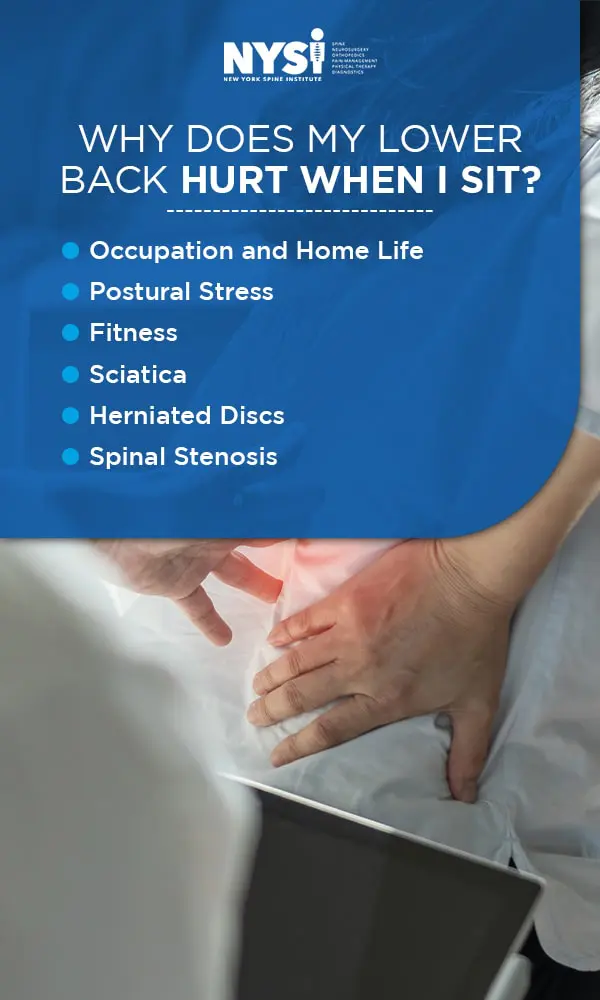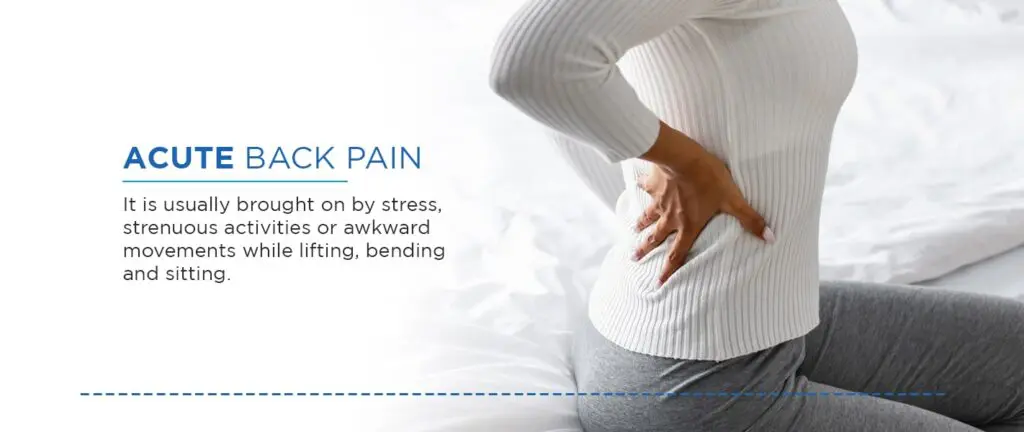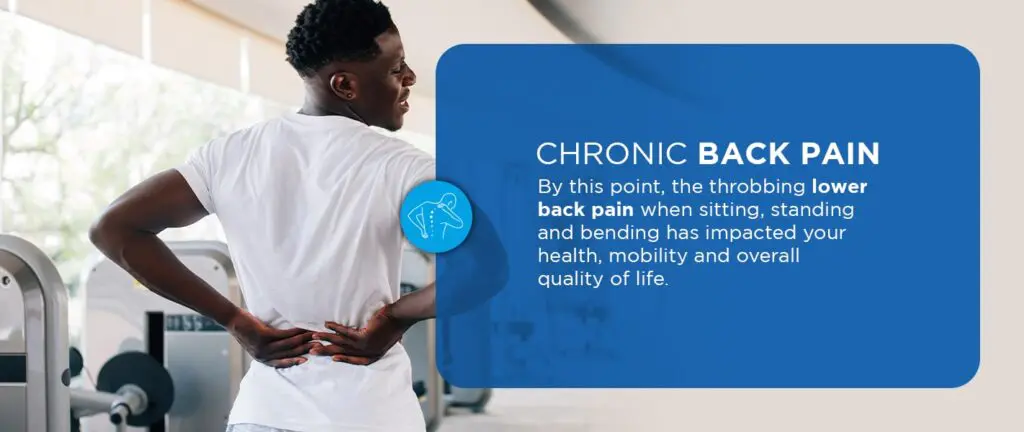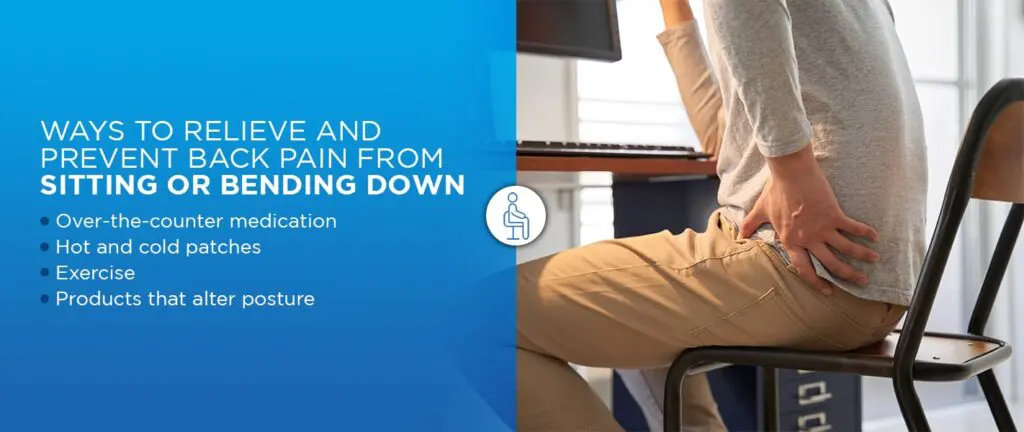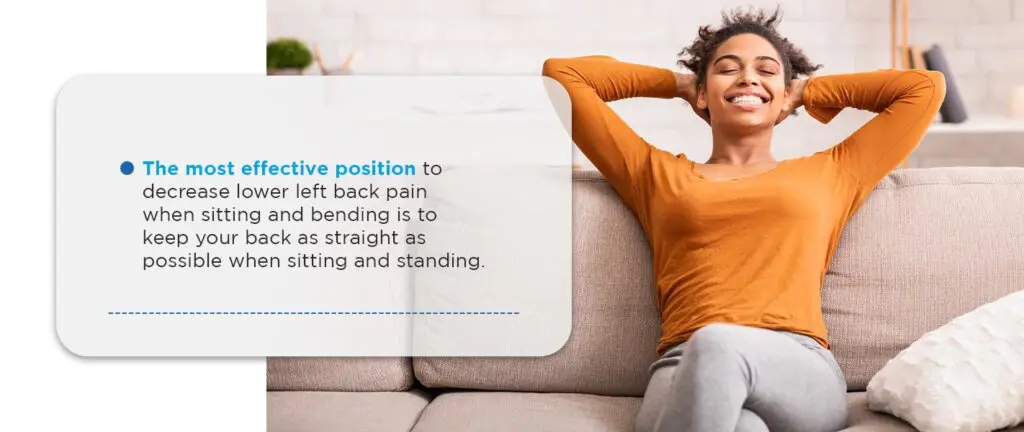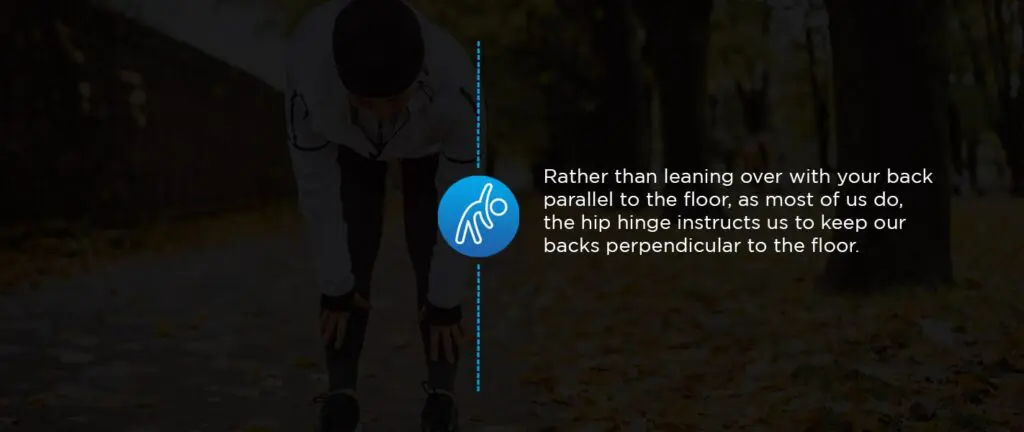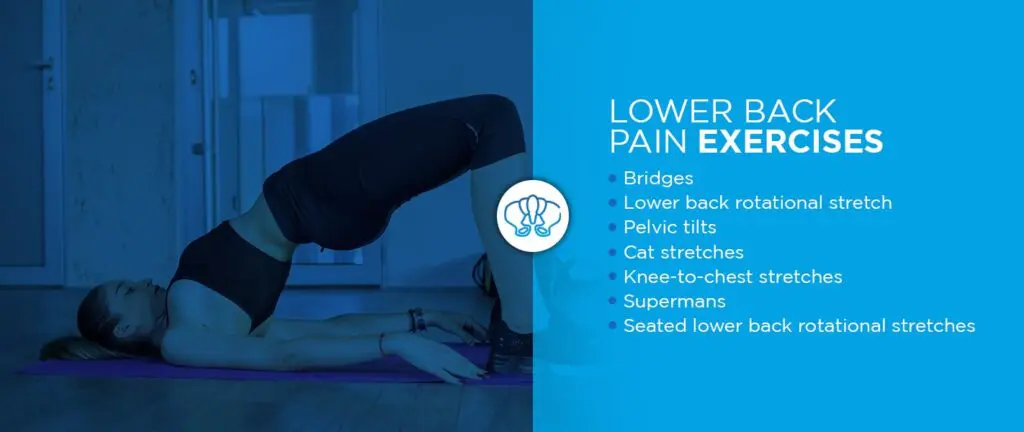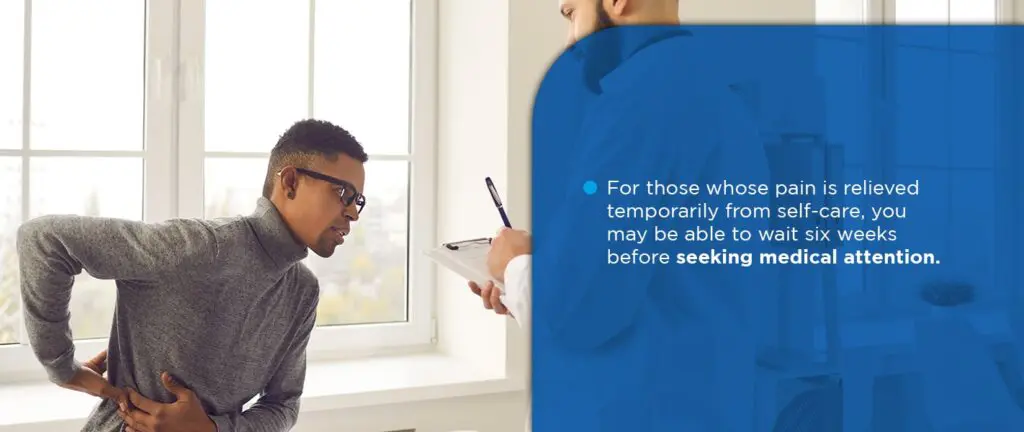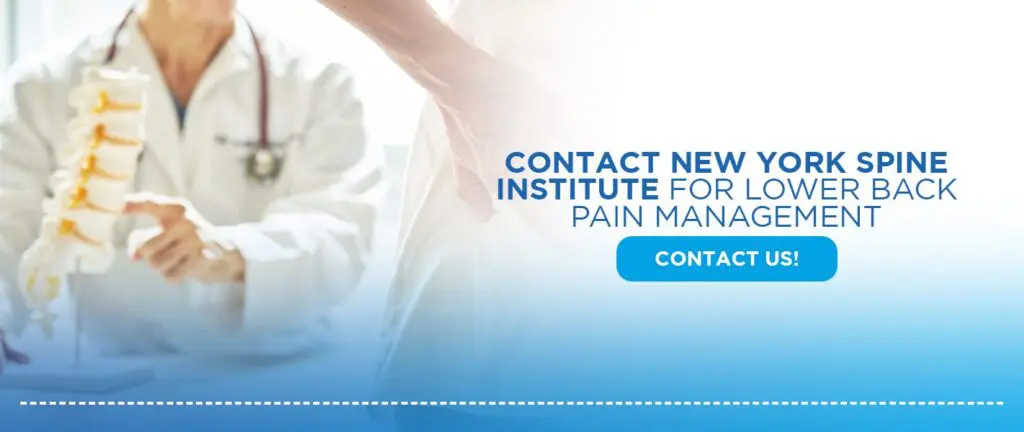Of that 80%, only about 25%-30% seek medical attention. Others justify the pain as everyday aches and pains. Most of the time, lower back pain is just that — a result of everyday activities and choices. The problem is knowing when the pain should be treated medically.
For those contemplating whether to seek medical assistance, let’s first break down why you have lower back pain when sitting and bending.
Why Does My Lower Back Hurt When I Sit?
Your back might hurt from sitting or bending down for many reasons. These causes can vary, depending on the severity of the pain and the positions in which you put yourself. In some cases, people may be unable to sit due to lower back pain and discomfort. Some possible reasons why you might experience lower back pain and stiffness when sitting include:
Occupation and Home Life
The most common reason for lower back pain when bending over or sitting is how we manage ourselves at work. Many people sit at a desk for roughly eight hours a day, five days a week. We keep ourselves in the same position for most of that time.
Prolonged sitting, especially in the same position, can cause your glutes to not fire properly due to your hip flexors being in their shortened position. Instead, you overwork your hamstrings. This can cause an anterior pelvic tilt (APT) or the excessive tilting of the pelvis.
Other occupations might demand more strenuous activities that can aggravate bad lower back pain when sitting down. These jobs require lifting — usually heavy lifting. While companies should provide proper equipment, most of us will find that we inadvertently lift with our backs rather than our legs and hips. We bend over to lift rather than squat down, and when we stand back up, the stress on our back muscles increases as we strain to stand upright again. Lifting this way could create difficulty moving or stiffness of muscles.
These issues persist even when you go home. After long days at work, you spend the evenings on the couch, relaxing.
Sleeping also has an impact on the lower back. After a night’s sleep, you might wake up with lower back pain and cannot bend down, making it difficult to perform daily tasks. Throughout the night, we contort our bodies into seemingly comfortable positions. You may attempt to accommodate animals, significant others or any other obstacle in the bed. The resulting positions can stiffen and strain your back muscles.
Learn More About Work Related Injuries
Postural Stress
Over our lifetimes, many of us subconsciously fall into rhythms and practices that contribute to postural stress. We find that sitting a certain way feels more comfortable at the cost of back strain. We habitually lift things using our back muscles rather than our legs and core, which can cause extreme lower back pain when bending.
When we sit, we apply about 90% more pressure on our back as opposed to standing. With proper posture, the pressure is evenly distributed between our back and core muscles.
Most people spend much of their days staring downward, usually looking at a phone, book or computer. On average, the human head weighs about 10 pounds. When we lean our heads forward, we overwork the muscles in our neck as they try to support the weight of the head.
Another source of postural stress occurs when we place our phones between our ears and shoulders while talking. This position pulls and strains the muscles on the opposite side of your head.
Fitness
Fitness can cause back pain while sitting but not standing for two key reasons.
The first is not using proper form when exercising. Weight lifting, yoga and other exercises that use the back and core can easily damage the nerves and bones in your back if done incorrectly. Always follow recommended positions and forms to minimalize the stress and damage done.
The second reasoning is lack of exercise and proper fitness techniques weaken the muscles that help us when sitting, bending and lifting. Exercise increases the strength of your muscles, making them better able to support the weight of your body.
Medical conditions such as obesity apply increased pressure on the back muscles when sitting and bending. Smokers and less-active people are also more likely to suffer from lower back pain when sitting and bending over. Additionally, people who partake in strenuous activities from a less active lifestyle will experience pain.
Sciatica
The sciatic nerve connects the base of the spine with the legs. Sciatica occurs when the sciatic nerve is irritated, and it can cause a dull aching sensation or the feeling of electrical shock. Sciatica may lead to the bottom of the back hurting when you sit down. If just your lower right or left back hurts when you sit, sciatica could be to blame.
Learn More About Sciatica and Treatment
Herniated Discs
A herniated disc is when excessive pressure or trauma forces a spinal disc out of place. It can cause severe lower back pain when trying to stand up and numbness around the afflicted area.
While herniated discs are more common in older people, sudden trauma from falling or lifting incorrectly can contribute to a disc being dislocated earlier in life.
Learn More About Herniated Discs and Treatment
Spinal Stenosis
The bones in our spines have hollow tubes running down them. These openings allow the nerves to make their way throughout the body. Spinal stenosis is when those hollow tubes squeeze or pinch the nerves and spinal cords. In some cases, patients with spinal stenosis may experience back pain that is worse when sitting.
Learn More About Spinal Stenosis and Treatment
Different Levels and Types of Pain
Like with most injuries, pain levels can vary depending on the person and the severity of the trauma. For example, some patients may experience lower back pain when sitting but not standing. On the other hand, some patients may only experience lower middle back pain when sitting. The different types of pain experienced could feel like:
- A sharp pain rather than dull aches: This type of pain could result from a torn ligament or muscle.
- A radiating pain that moves from various parts of the lower back: This pain could originate from nerve compression.
- A numbness or tingling sensation: This feeling will originate specifically in the groin and glutes area.
- Incontinence: The intensity of the lower back pain may affect your ability to control your bladder.
- Sudden leg weakness: The inability to walk is related to nerve damage, usually linked to spinal stenosis.
Many people may experience severe lower back pain when sitting down. It may feel likea constant ache deep within the muscle or a sharp jabbing sensation as if someone is stabbing you with needles. If you suffer from leg weakness, incontinence and numbness in the groin and glutes, you might have cauda equina syndrome and should seek medical attention immediately. For some, the pain might originate from the tailbone, making it painful to sit in specific positions.
After sitting, standing, bending and sleeping for extended periods, your back might become stiff or tight, making it difficult to move or bend. The pain might be severe enough that it causes discomfort when trying to sleep.
When treating your condition, it’s important to distinguish between acute and chronic back pain.
Acute Back Pain
Many people will suffer acute back pain in their lives. Acute pain comes along suddenly and only lasts for a short while. It is usually brought on by stress, strenuous activities or awkward movements while lifting, bending and sitting. For most people, the causes of acute back pain do not constitute any serious long-term condition or require immediate medical attention. The pain should last no longer than six weeks at a time.
Most of the time, simple home remedies or self-care can help alleviate most — if not all — of the pain. Over-the-counter pain medications, massages or hot and cold patches should be enough to reduce the pain.
Chronic Back Pain
If the pain lasts longer than six weeks, you most likely suffer from chronic back pain and should seek medical attention. By this point, the throbbing lower back pain when sitting, standing and bending has impacted your health, mobility and overall quality of life.
Chronic pain can come on gradually rather than all at once. It lasts anywhere from six weeks to six months and can trigger on and off regularly. More importantly, however, is that home remedies don’t soothe and relieve the pain.
Learn More About Chronic Back Pain
Ways to Relieve and Prevent Back Pain From Sitting or Bending Down
Before going to the doctor, here are several quick and easy methods you can try to improve lower back pain when pressure is applied.
- Over-the-counter medication: The quickest way to alleviate pain is over-the-counter medicine, such as acetaminophen and ibuprofen. Be sure to follow the directions on the bottle, and don’t exceed the recommended dosage.
- Hot and cold patches: Hot and cold patches help fight the pain at the source. If the pain results from an overextended muscle or joint, the combination of hot and cold relaxes and reduces inflammation in the muscle.
- Exercise: Exercise is an effective way to fortify the muscles that control the lower back. A doctor can recommend specific exercises for your pain.
- Products that alter posture: Standing desks and ergonomic chairs are perfect for helping you manage your posture at work. Inversion tables are a great way to decompress the spine. They have been proven to provide 100% decompression of the spine when inverted at a 60-degree angle. Meanwhile, foam rollers can be used to massage out any knots or pains in the back from sitting for too long. Massage chairs are also great at working on the afflicted area of the back to relieve the pain.
If none of these methods help, you can also try seeking professional, non-extreme medical assistance from professionals such as:
- Massage therapists
- Physical therapist.
- Orthopedic specialists.
- Pain management specialists.
Massages are a great way to target specific areas of pain. Licensed massage therapists know where and how to alleviate the inflamed area. Sometimes, lower back pain might occur after surgery or other medical treatments. Some surgeries repair muscles, bones or joints in the back, and your body may need time to acclimate to its new functions. Physical therapists assist with training your body to more effectively repair itself and decrease discomfort and pain.
Orthopedic specialists and pain management specialists can also treat lower back pain with an array of treatment options depending on the specific causes of your discomfort.
Best Sitting Positions for Lower Back Pain
Many people spend about eight hours sitting at a desk. Depending on the severity of the back pain, a proper sitting position is one of the first steps to eliminating the pain. The U.S. Department of Health and Human Services offers several suggestions in maintaining good sitting posture, including:
- Refrain from slouching while sitting and standing.
- Sit up straight with your feet on the ground and back against the chair.
- Keep knees slightly higher than your hips.
- Stand with your back straight, shoulders back and head up.
- Switch between a sitting and standing position when possible.
The most effective position to decrease lower left back pain when sitting and bending is to keep your back as straight as possible when sitting and standing. Doing so will help release strain on your back muscles. When done properly, you will feel your back stretch and lengthen.
Alternating standing and sitting keeps your muscles moving rather than in a static and stressed position. When sitting, your muscles stretch and conform to accommodate the position. Maintaining that position for an extended period will cause your back to over-exert itself and cause stiffness or pain when switching positions.
Best Way to Bend Over With Lower Back Pain
The most effective way to bend down with back pain is to refrain from using your back muscles while bending. Instead, bend using your hips and thighs using a method called the hip hinge.
Rather than leaning over with your back parallel to the floor, as most of us do, the hip hinge instructs us to keep our backs perpendicular to the floor. The bending motion is made with your hips and thighs, similar to a squat. The hips are better equipped to handle the strain of the bend by using the hamstrings. The hip hinge technique relaxes your back muscles when you bend instead of tightening them.
Using your hips to bend eliminates the need to use your back and prevent any pain from flaring up.
Lower Back Pain Exercises
Exercise has two important functions when it comes to lower back pain. First, exercise can reduce or eliminate the pain you are currently experiencing. Continued exercise can also reduce or prevent lower back pain.
Yoga is the most common and effective method for achieving both results. Yoga forces you to stretch and lengthen the muscles in your lower back. It can decrease current pain and increase muscular support.
As with all exercise, yoga does come with certain risks. Certain poses may be too difficult to do right away. Be cautious of overextending or further damaging the back by contorting into uncomfortable poses. If you feel any pain, stop immediately. Take your time and slowly work up to those poses.
Pilates is another great way to decrease lower back pain. It can reduce neck and back pain without causing additional irritation.
Stretches are also significant in building strength in your back. Here are some beneficial stretches you might consider:
- Bridges
- Lower back rotational stretch
- Pelvic tilts
- Cat stretches
- Knee-to-chest stretches
- Supermans
- Seated lower back rotational stretches
Doing one or more of the above stretches can help increase blood flow to the afflicted areas. The increased blood flow will quicken the healing process.
Decreasing and eliminating lower back pain involves more than just exercising your back muscles. You should focus on the core muscles as well. This group of muscles reinforces the back muscles when we sit and bend. They are essential in distributing some of the stress and pressure normally placed on the lower back muscles.
When You Should See a Doctor for Back Pain
Many people struggle with knowing when their pain is severe enough to see a doctor. While most sources vary on a recommended time frame, the consensus is to see a doctor if pain persists for 2-6 weeks. Depending on the severity of the pain or if the self-caring techniques don’t work, you might decide to go after two weeks of consistent pain.
For those whose pain is relieved temporarily from self-care, you may be able to wait six weeks before seeking medical attention. Always seek medical attention sooner rather than later. You never know if the pain is caused by some underlying medical emergency. If you experience lower back pain and cannot sit or perform other daily tasks, you may want to see a doctor. More than anything, going to the doctor can help rule out any serious underlying medical conditions.
If the pain is brought on by doing specific actions, such as your lower back hurting when sitting and getting up, but goes away after 72 hours, then you may not need to worry about seeing a doctor. However, if the pain creeps on, comes on suddenly or lingers for too long, then you should consider seeing a doctor.
Sometimes, situations arise where you should seek medical attention immediately. Seek immediate medical attention if you have:
- Unexpected increase in back pain, discomfort, weakness or numbness.
- Loss of bladder function.
- High fever.
- Severe stomach pain.
- Unexplained weight loss.
- Pain resulting from a severe fall or trauma to the back.
In these cases, you should seek immediate medical attention from an emergency room.
Contact New York Spine Institute for Lower Back Pain Management
Some individuals have a higher pain tolerance than others and may believe that they can work through the pain. Some patients’ lower backs hurt when sitting and bending and want to seek medical attention immediately. Either way, lower back pain that hurts when sitting, standing or lifting should not be taken lightly.
No matter the situation, no one should have to live through life in pain, so why should you? Take the necessary steps to decrease lower back pain and live the life you want free of pain with help from New York Spine Institute. Our services include pain management, physical therapy and other medical services to help you diagnose and treat your low back pain.

